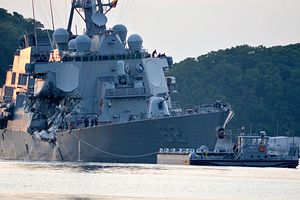This week the Commander of the U.S. Seventh Fleet concluded administrative proceedings on the leadership of the Japan-based destroyer USS Fitzgerald, as well as the conduct of the officers and sailors on watch when it collided with the merchant vessel ACX Crystal in June. At the same time, the U.S. Navy released a preliminary investigation into the collision’s aftermath, detailing the escape of 28 sailors from one of the Fitzgerald’s flooded berthing compartments where seven other sailors became trapped and drowned, and the efforts to repair damage enough to bring the ship back to port.
Vice Admiral Joseph Aucoin relieved the Fitzgerald’s Captain, Executive Officer, and senior enlisted leader of their positions for a “loss of confidence” in their ability to lead. While none of the top leadership were present at control stations when the collision occurred, they were held accountable for the lack of watchstander preparedness that contributed to the failures of teamwork and seamanship by bridge team and Combat Information Center leading up to it. A dozen sailors and officers who were on watch when the collision occurred also faced administrative punishments, but these were not specified.
The Non-Judicial Punishment handed down by Admiral Aucoin was based on facts and details from the ongoing investigation into the collision, which has collected over 3000 pages of evidence thus far. According to the Seventh Fleet spokesperson:
The collision was avoidable and both ships demonstrated poor seamanship. Within Fitzgerald, flawed watch stander teamwork and inadequate leadership contributed to the collision that claimed the lives of seven Fitzgerald Sailors, injured three more, and damaged both ships.
A larger Navy investigation being led by Rear Admiral Brian Fort is tasked with determining fault for the collision, and some of the disciplined sailors and officers may also face judicial proceedings in a court martial when it is completed.
Separately, the Navy released a 41-page investigation into the events following the collision. This investigation into damage control and rescue efforts was circumscribed from looking into the events leading up to the collision.
The report detailed the harrowing events in the Fitzgerald’s Berthing 2 compartment. The ACX Crystal’s bulbous bow pierced the Fitzgerald’s hull and opened the berthing compartment, where 35 sailors were sleeping, directly to the sea. There were no alarms or warning prior to the collision and sailors estimate that the compartment was flooded within 60 seconds. To escape, sailors had to wade through rapidly rising water in near-darkness except for emergency battle lighting and climb up a ladder and then pull themselves up through a two-foot diameter scuttle hatch to a landing one deck above. The last sailor to make it out had to free himself, already nearly underwater, from being pinned under lockers wrenched loose by the force of the collision. By the time he reached the scuttle the compartment had flooded completely and he began breathing in water when he was pulled out by sailors reaching into the onrushing water.
Waiting to save that last sailor meant that the rush of rising water through the scuttle prevented sailors from being able to seal it and contain the flooding. The berthing compartment above Berthing 2 also began to flood and sailors had to evacuate to the main deck above it and seal the two compartments from there. Seven sailors did not make it out of Berthing 2 and perished in the flooding.
Elsewhere, the ship’s Captain was trapped in his mangled cabin, which was ripped open by the ACX Crystal’s flared bow. Crew found him hanging from the side of the ship after battering down and prying back the door to his cabin, finally reaching him after clearing debris and crawling through torn superstructure, forced to use their belts as a makeshift harness to keep from falling overboard themselves.
According to the Navy’s timeline, power was lost in the forward half of the ship as flooding progressed, the radio room was damaged – the ship first alerted the Navy about the collision via a sailor’s personal cell phone – primary navigation sensors were lost, a major engineering space was flooded, and one of two main engine rooms lost power. Making three knots on one propeller shaft and with the assistance of tugs sent from Yokosuka, the Fitzgerald was moored back there seventeen hours after the collision, her bow sitting low in the water.
The Navy announced in August that the Fitzgerald will be removed to the United States for repairs on a heavy lift ship, just as the USS Cole was when it was struck by a terrorist bomb in Yemen. The repairs could be completed in Yokosuka, but the Fitzgerald’s damage is so extensive that it would tie up too much of the yard’s capacity, which must also service repairs to eleven other ships forward deployed to Japan.
Analysts estimate that the repairs could easily cost more than a half-billion dollars, more than twice what the repairs to the USS Cole cost, largely due to extensive damage to sensitive electronic combat systems equipment. The collision heavily damaged one of her SPY radar arrays, and may have twisted the superstructure they are mounted on. The SPY radar is the centerpiece of the destroyer’s AEGIS Weapon System that enables her air defense and ballistic missile defense missions, and must be precisely mounted and aligned.































